A classic, old-fashioned, Southern cast iron cornbread — just like Grandma made it! With crisp, buttery edges from the cast iron skillet, and a moist, tangy flavor and texture, this easy side dish works well for breakfast, lunch, or dinner.
Thank you for reading this post, don't forget to subscribe!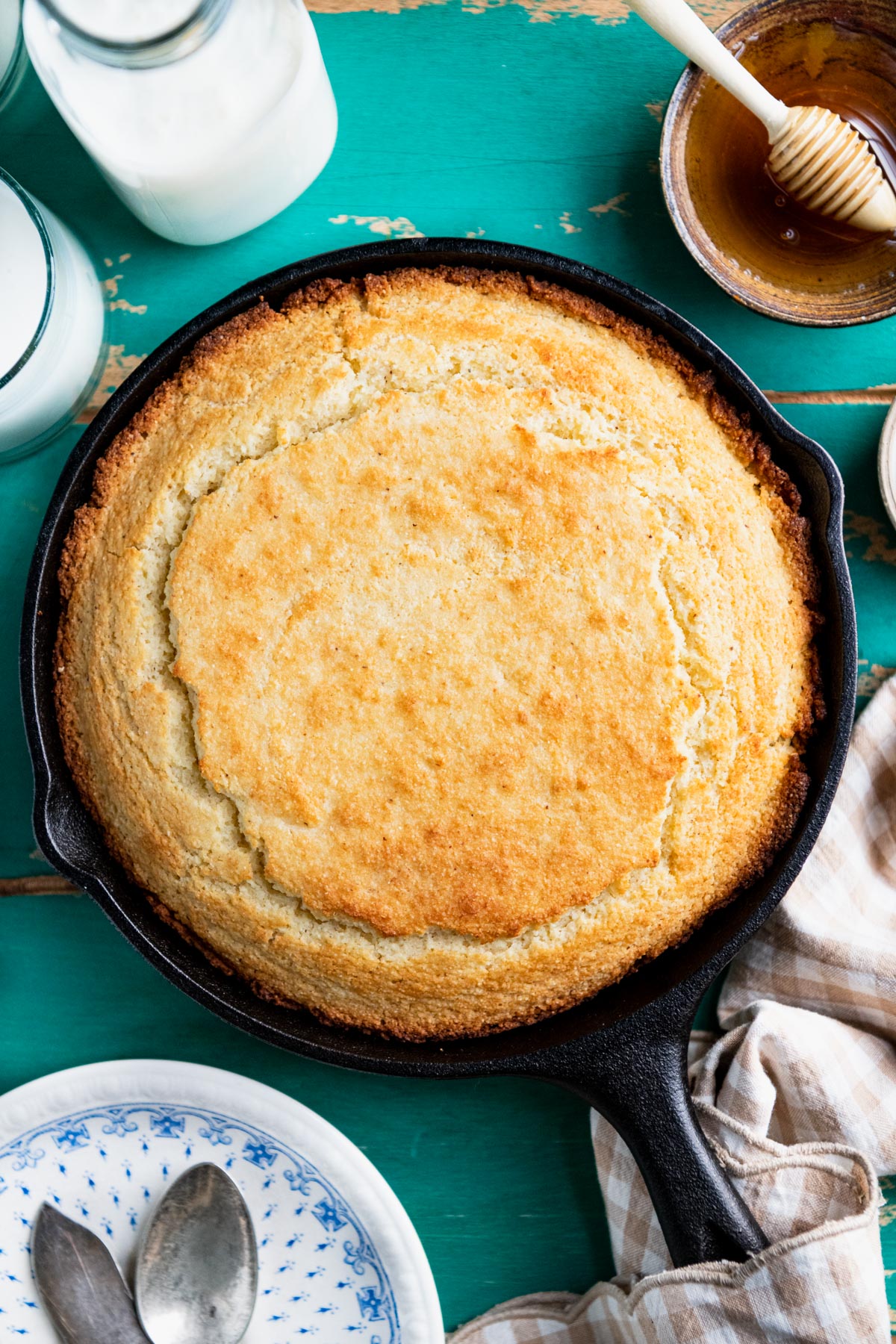
My love for cornbread runs deep, and I’m not too particular when it comes to the style! While a sweet, cake-like northern cornbread recipe has its place on my table (it’s definitely my kids’ preference), this southern cast iron cornbread will always have my heart.
Nothing quite says “comfort” like a skillet of warm cornbread, only made better with a drizzle of honey or a slathering of extra butter and apple butter. It’s perfect for soaking up chili, beans, gravy, or anything else that might be lingering on your plate, and equally delicious for breakfast alongside a mug of hot coffee.
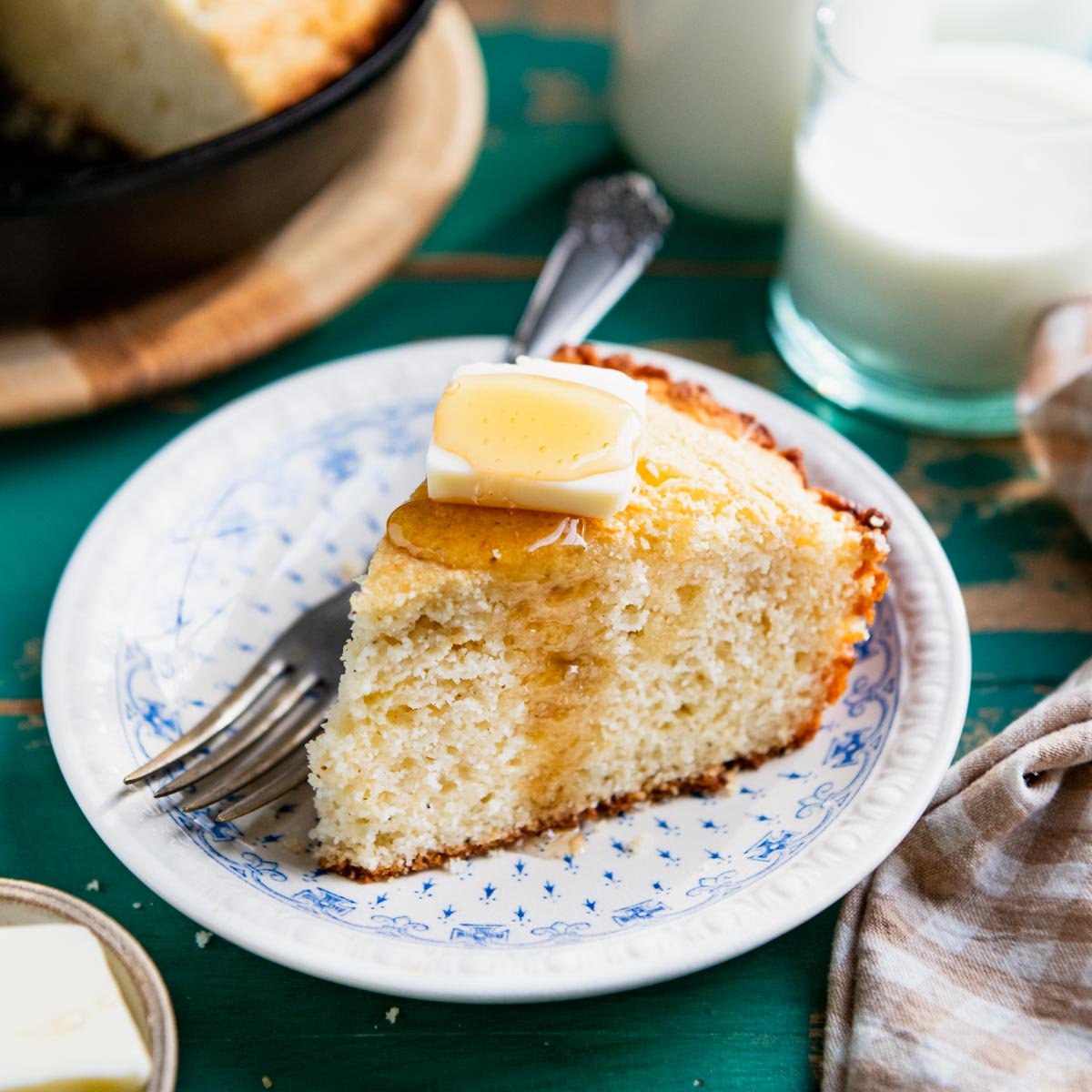
Why Cornbread is Better in a Cast Iron Skillet
For the best cornbread, you’ve got to use a cast iron pan! I recommend a deep 8-inch cast iron skillet for this recipe, but corn stick pans are also fun. A 9-inch cast iron skillet will work — it just yields thinner slices of bread. And in a pinch, you can substitute with an 8-inch baking dish.
Baking cornbread in a preheated cast iron skillet creates extra-crispy edges, which you just can’t replicate with any other pan. The cast iron retains and distributes heat evenly, so that the cornbread cooks beautifully and comes out tender and moist on the inside, but crispy on the outside. That buttery, browned, sturdy crust is the best part of the cornbread — a total dream!
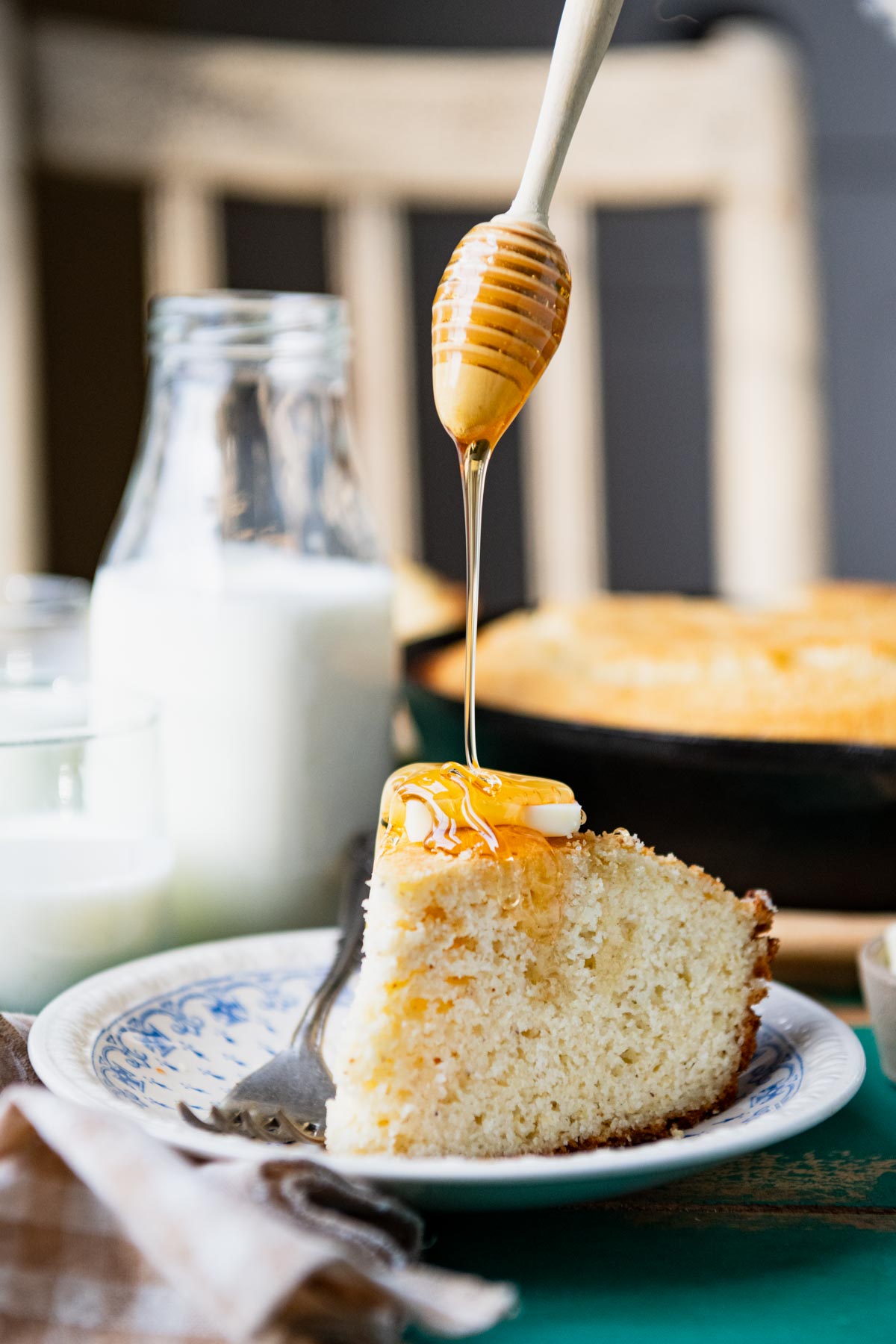
Does cornbread stick to cast iron?
No, the cornbread will not stick to your cast iron skillet. A properly seasoned cast iron pan is naturally nonstick. You will also melt butter all over the bottom and sides of the pan before pouring in the batter, which prevents the cornbread from sticking and adds great flavor to the crust.
Should I let cornbread cool before removing from cast iron?
Let the cornbread cool slightly in the skillet before slicing and serving. It will be a bit sturdier (and less crumbly), and the hot skillet will be a bit easier to handle as it cools slightly. The cornbread is great served warm or at room temperature.
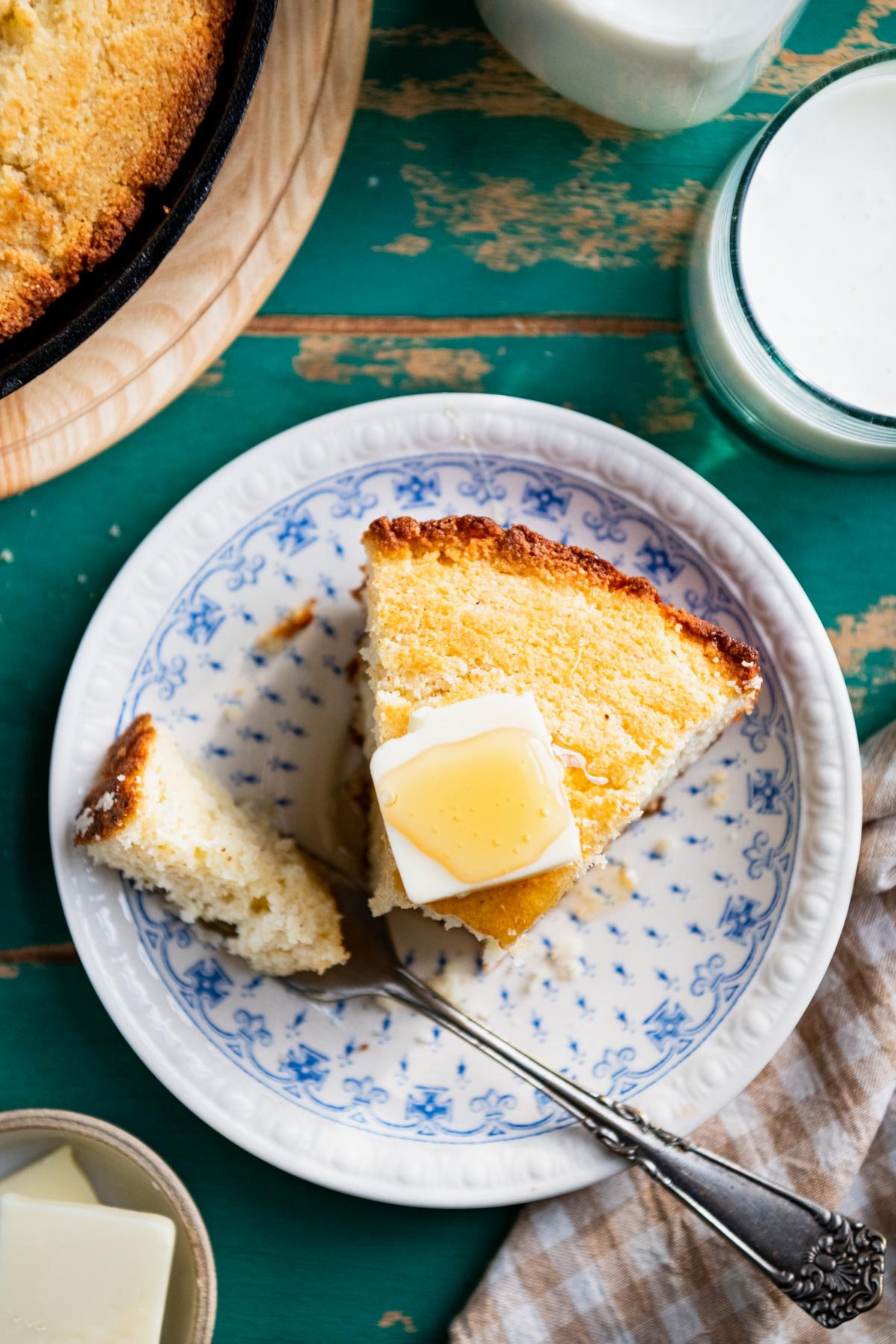
Ingredients
This is just a quick overview of the ingredients that you’ll need for this easy cast iron cornbread. As always, specific measurements and step-by-step cooking instructions are included in the printable recipe box at the bottom of the post.
- Buttermilk: use whole buttermilk for the best flavor and texture. The buttermilk adds moisture to the bread, yields a softer crumb, and provides a slightly tangy flavor and richness. The acid in the buttermilk also activates the leavening agents to help the cornbread rise.
- Egg: gives the cornbread structure and lift.
- Vegetable oil: keeps the cornbread moist.
- Self-rising cornmeal mix: use either white or yellow self-rising cornmeal mix. I prefer White Lily brand. This is not plain yellow cornmeal! Instead, self-rising cornmeal mix is a convenient blend of cornmeal, all purpose flour, leavening agents (like baking soda), and salt.
- Sugar: an optional ingredient! A traditional Southern cornbread recipe does not include any sugar, so feel free to leave this ingredient out if you like savory cornbread.
- Butter: to grease the hot skillet and flavor the crust.
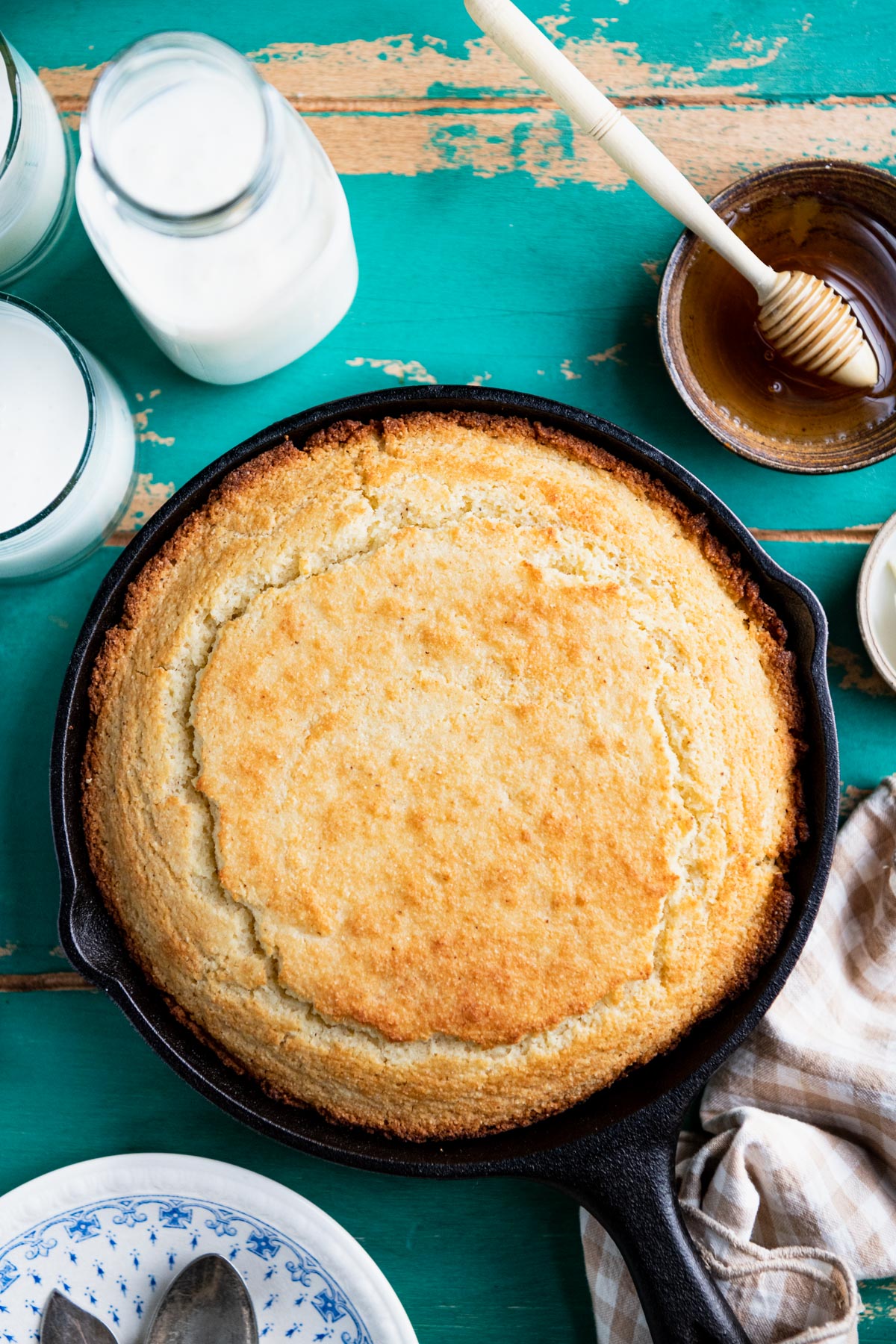
Why add buttermilk to cast iron cornbread?
Buttermilk is a classic Southern pantry staple that we always keep in the fridge! From fluffy pancakes to salad dressing, hoe cakes and biscuits to fried chicken, it’s an important ingredient in so many of our favorite recipes — including this Southern cornbread. In fact, if you have any leftover buttermilk, check out this collection of more than 60 recipes with buttermilk. The buttermilk serves a couple of purposes in this recipe that you can’t achieve with regular milk:
- Flavor: the buttermilk gives the cornbread a nice, subtle tanginess.
- Acidity: the acid in buttermilk helps the cornbread rise, because the acid from the buttermilk reacts with the alkaline baking soda, causing it to give off carbon dioxide. Baking powder will also react with buttermilk’s acidity to a small degree.
- Texture: the fat and acid in the buttermilk yields a lighter, more tender crumb.
I get my buttermilk at a local country market near our house — and this is the REAL stuff — the liquid that runs off a batch of fresh butter. It makes the most delicious biscuits and cornbread! The buttermilk that you buy in a grocery store is probably just cultured milk (check the label) — which is a far cry from the real thing. If you have access to a local dairy or similar small market, I highly recommend getting your hands on the ultra-thick, ultra-rich buttermilk that will truly make your Southern cornbread stand out.
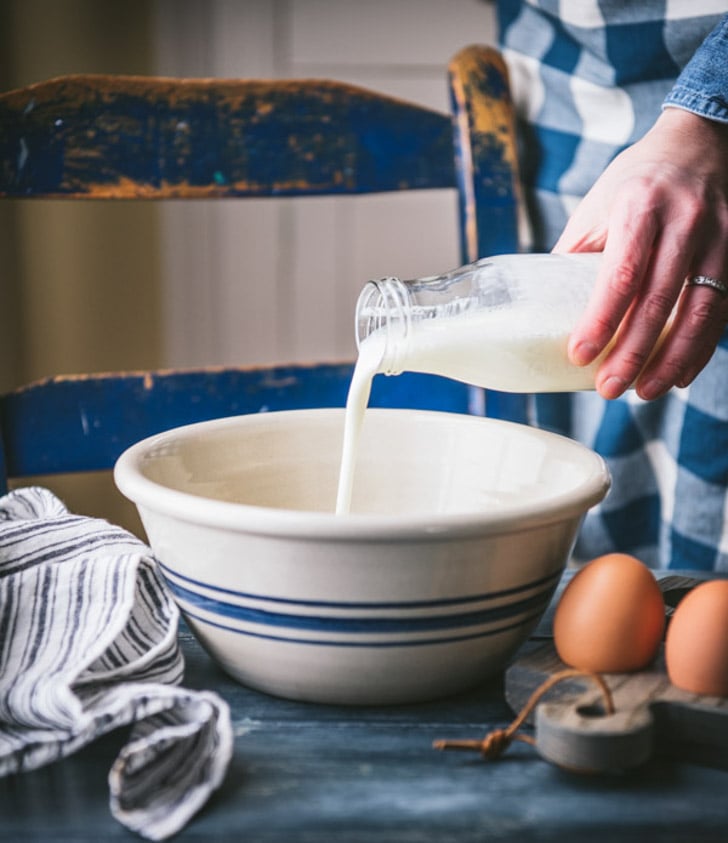
Buttermilk Substitutes
Don’t have buttermilk? No problem! In a pinch, you can make your own buttermilk at home to use in this recipe. To do so, pour either 1 ½ tablespoons of freshly squeezed lemon juice or 1 ½ tablespoons of white vinegar into a large measuring cup. Add enough whole milk to equal 1 ½ cups of liquid. Give it a stir, let it sit for about 5 minutes, and then use it in the recipe as directed!
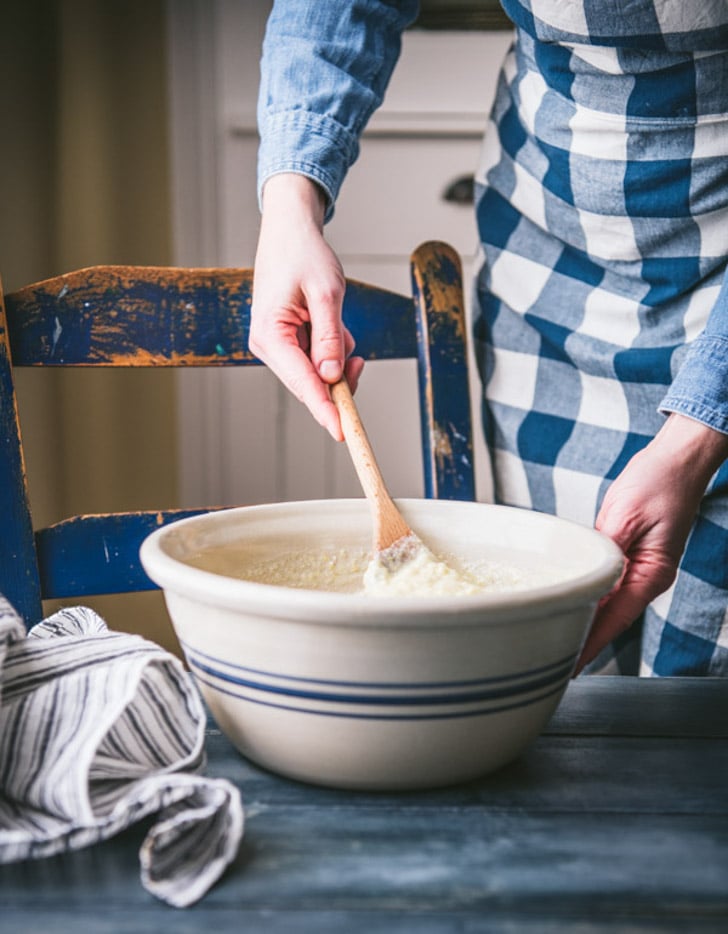
How to Make Cornbread in a Cast Iron Skillet
This easy cast iron skillet cornbread recipe is adapted from the original White Lily Flour recipe. It’s my go-to when we need a simple side dish to pair with supper multiple times per week! I’ve included the detailed baking instructions in the recipe card at the bottom of the post, but here’s the quick version:
- Preheat a cast iron skillet in the oven.
- Whisk together the wet ingredients.
- Stir in the dry ingredients.
- Butter the hot skillet, and then pour in the batter.
- Bake for 25 minutes, until beautiful and golden brown.
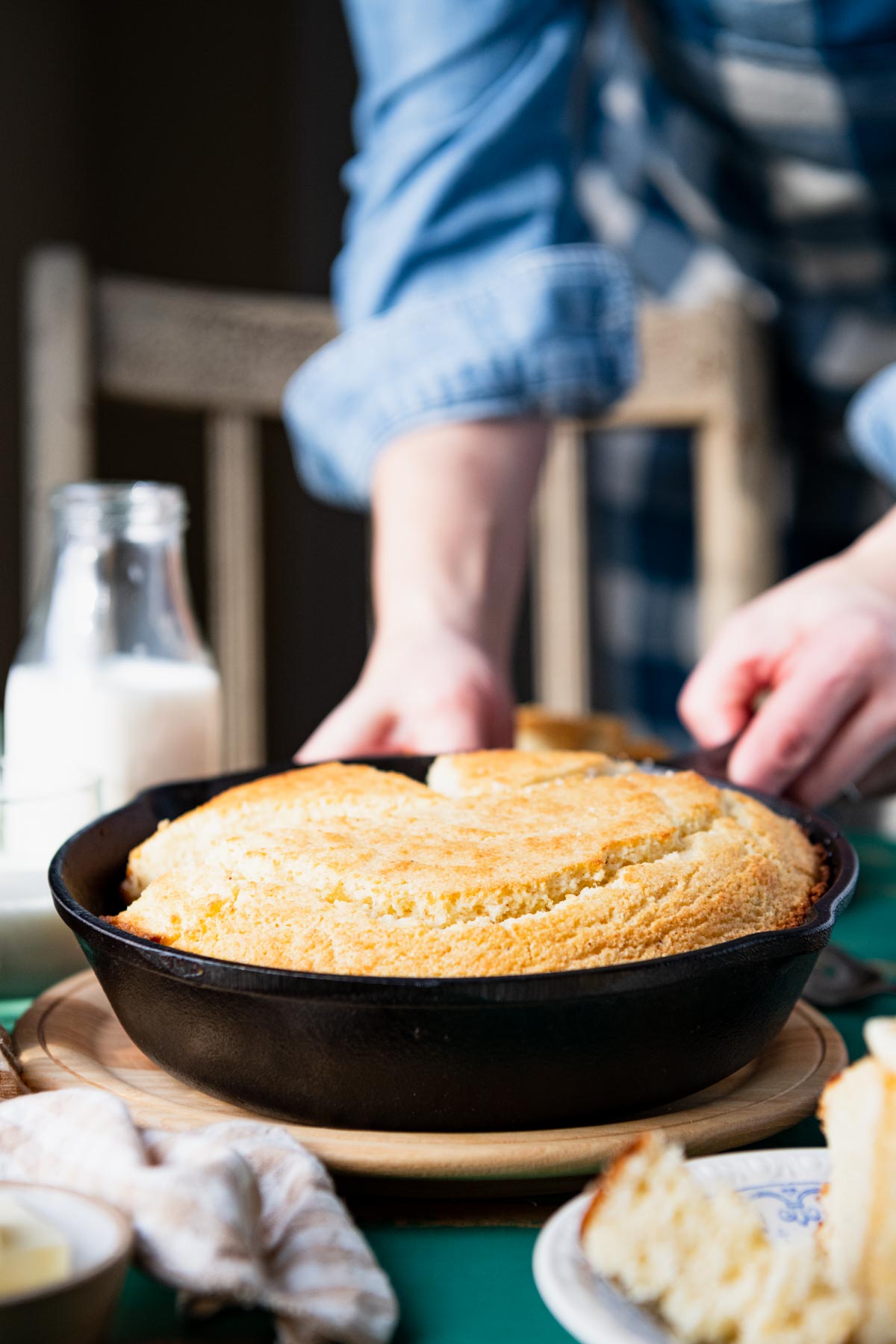
Serving Suggestions
Serve the cast-iron cornbread recipe with butter, honey, honey butter, jam, apple butter, or syrup. As a side dish, the cornbread goes well with any of these dinner entrées:
- Chili (like this Slow Cooker Chili, Beef and Beer Chili, Classic Beef Chili, Slow Cooker White Chicken Chili, White Bean Chicken Chili, Texas Chili, Ground Turkey Chili, or Pumpkin Chili)
- Soup (such as Ham and Bean Soup, Southern Black-Eyed Pea Soup, Beef Barley Soup, Crock Pot Potato Soup, Split Pea Soup with Ham, Chicken Noodle Soup, Pumpkin Soup, Chicken Vegetable Soup, Hamburger Soup, or Creamy Cauliflower Soup)
- Stews (like this Crock Pot Brunswick Stew, Crock Pot Chicken Stew, Irish Stew, Frogmore Stew, or Dutch Oven Beef Stew)
- Beans (such as Appalachian Pinto Beans and Turnip Greens, Black-Eyed Peas, Homemade Baked Beans with Bacon, Southern Lima Beans with Ham, Ranch Style Beans, or Cowboy Baked Beans)
- Barbecue (like these Crock Pot Ribs, Pulled BBQ Chicken, Dutch Oven Beef BBQ, or Pulled Pork)
- Meat (try this Southern Meatloaf, Pan Fried Pork Chops, Oven-Fried Breaded Pork Chops, Dutch Oven Pot Roast, Pork Roast with Gravy, Rosemary Oven Roasted Chicken, or Crispy Roast Chicken with Vegetables)
- Seafood (such as Shrimp and Grits, Crab Cakes, and Shrimp Creole)
- Fried Favorites (such as Fried Chicken, Chicken Fried Steak, Fried Catfish, Oven-Fried Fish, Fried Oysters, or Fried Shrimp)
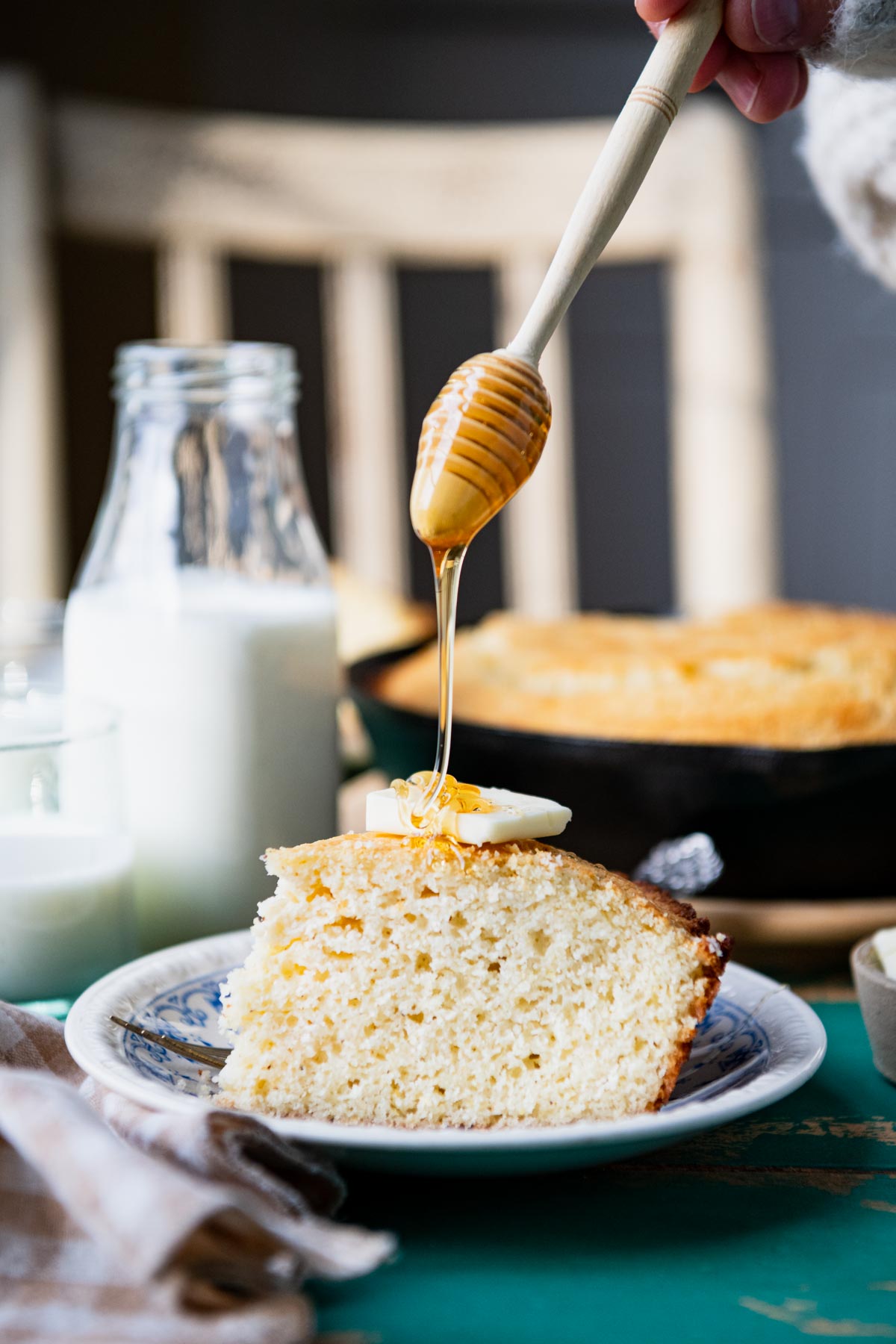
Preparation and Storage
Cornbread is best when freshly baked and warm from the oven, but you can bake it up to 8 hours in advance and leave it on your countertop until ready to serve. To extend the life of your homemade cornbread, store in an airtight container or cover with plastic wrap at room temperature for 1-2 days or in the fridge for up to 1 week.
How to Freeze
Wrapped tightly, you can store cornbread in the freezer for up to 3 months. Thaw on your countertop or in the refrigerator before enjoying.
How to Reheat
To reheat leftover cornbread, wrap in foil and warm in a 325°F oven for about 10 minutes. You can also microwave individual slices of cornbread just until warmed through — about 20-30 seconds.
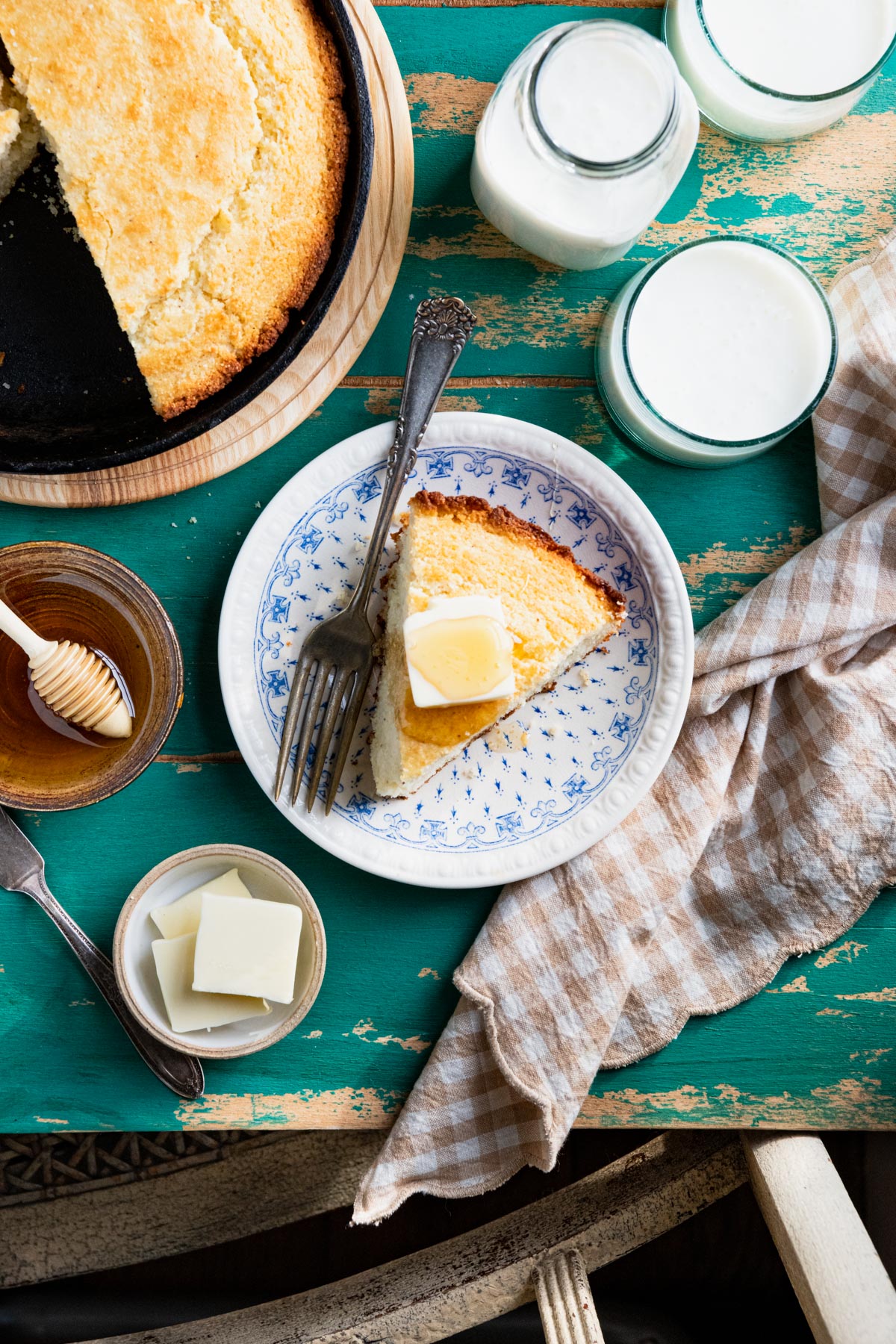
Recipe Variations
- If you prefer a sweet cornbread, try this recipe. It’s like a cornbread skillet cake!
- Omit the sugar for a savory cornbread.
- Don’t have an 8-inch cast iron skillet? Use a 9-inch skillet or an 8-inch baking dish.
- Make your own self-rising cornmeal mix with these directions, or stir together your own buttermilk substitute by following the instructions above.
- Optional add-ins: 1-2 chopped jalapeño peppers, 1 cup fresh blueberries, 1 cup shredded cheddar or Pepper Jack cheese, or orange zest and dried cranberries.
- For cornbread muffins, try this recipe.
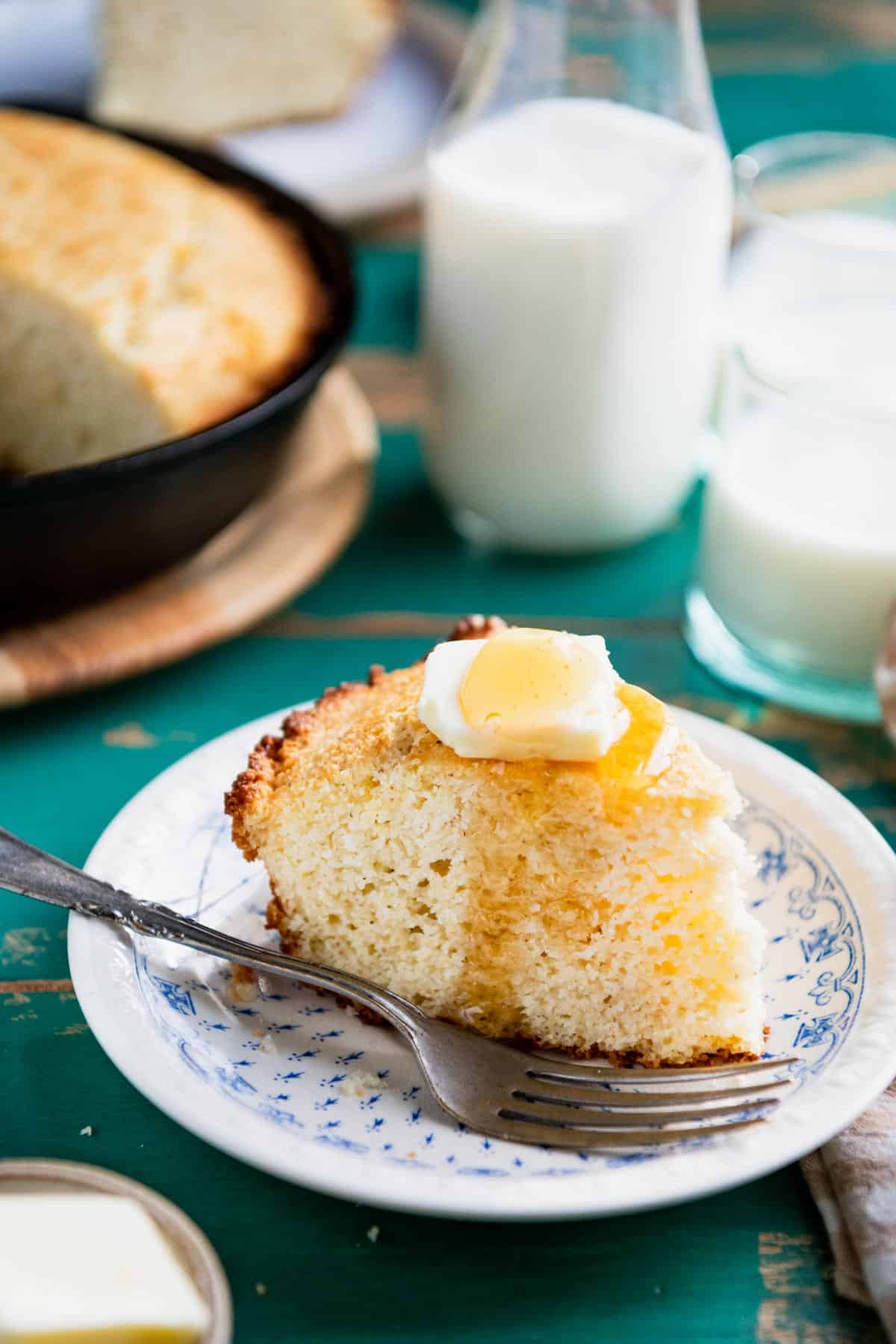
TIPS FOR THE BEST CAST IRON SKILLET CORNBREAD RECIPE
- Make sure that you’re using self-rising cornmeal mix — not plain cornmeal. The self-rising mix includes some flour, salt, and leavening agents in addition to the cornmeal.
- Always preheat your cast iron skillet for cornbread. The hot skillet creates a crisp, sturdy crust on the cornbread, which is a flavorful, delicious contrast to the tender, delicate crumb.
- Use full-fat buttermilk rather than a lower-fat alternative. The fat in the liquid adds richness to the batter and helps to keep the cornbread moist.
- Let the batter rest for 5-10 minutes before baking, if you have the time. This allows the leavening agents to activate and incorporate more air.
- Don’t over-mix the batter or it will become too dense, and you’ll end up with dry cornbread.
- To check if the cornbread is done, insert a toothpick into the center and make sure it comes out clean. Don’t cook for too long, or it can dry out.
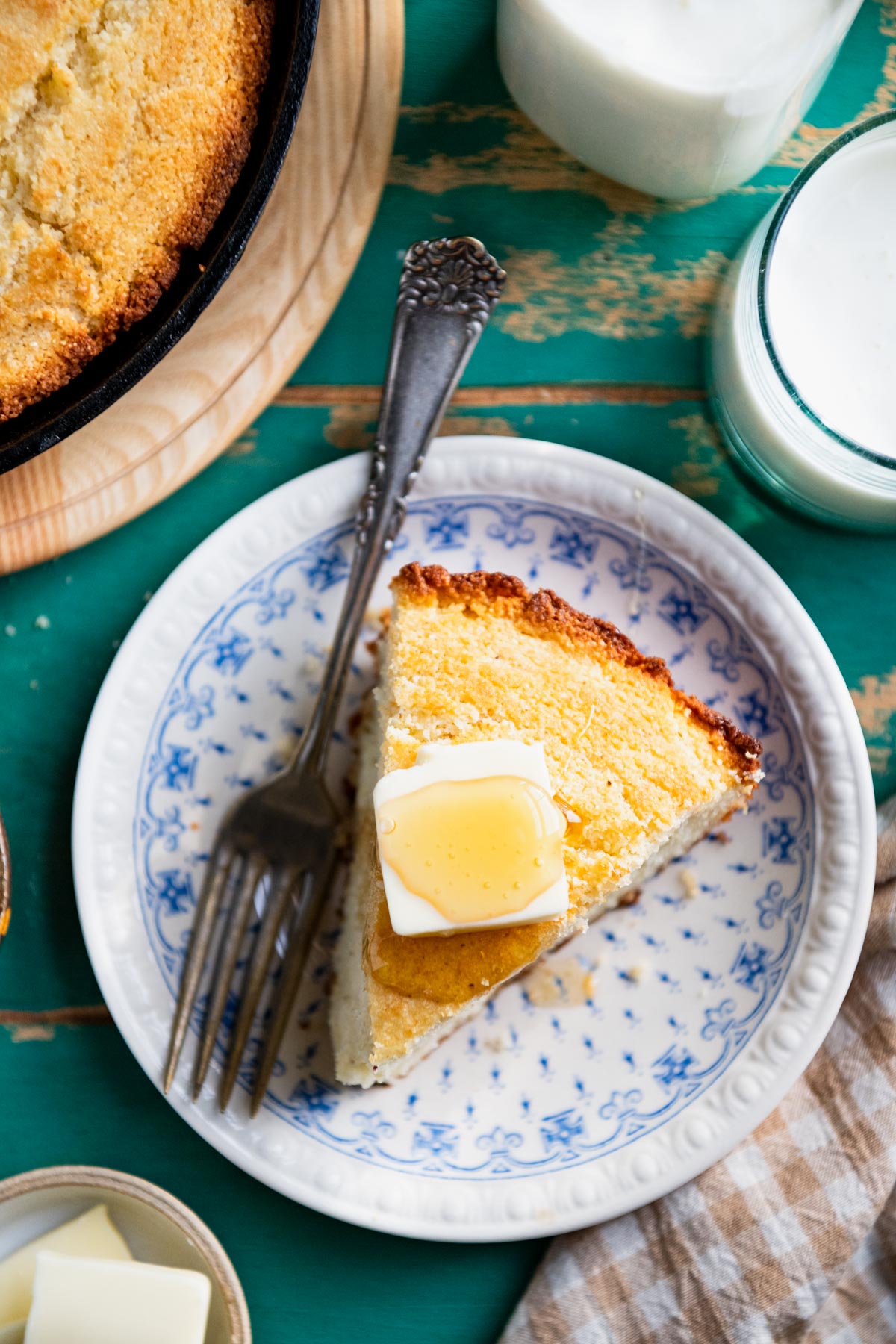
Cast Iron Cornbread
Equipment
- 8-inch cast iron skillet
Ingredients
- 1 ½ cups whole buttermilk well shaken
- 1 large egg
- ¼ cup vegetable oil
- 2 cups self-rising cornmeal mix not plain cornmeal (I prefer White Lily brand)
- 2 tablespoon sugar (optional)
- 1 tablespoon butter
Instructions
- Heat an 8-inch cast iron skillet in the oven while you preheat the oven to 425°F.
- Meanwhile, in a large bowl, whisk together the buttermilk, egg, and oil.
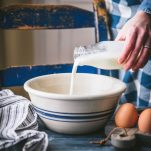
- Add the cornmeal mix and sugar; stir just until combined. Do not overmix – the batter will be lumpy, which is fine.
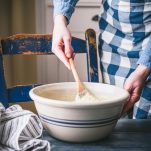
- Once the oven comes to temperature, carefully remove the skillet. Place the butter in the skillet; use a knife or brush to spread the butter on the bottom and sides of the pan until it melts.
- Pour the batter into the buttered skillet.
- Bake for about 25 minutes, or until a toothpick inserted in the center comes out clean.
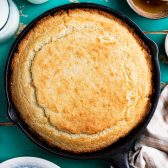
Notes
- Make sure that you’re using self-rising cornmeal mix — not plain cornmeal. The self-rising mix includes some flour, salt, and leavening agents in addition to the cornmeal.
- Always preheat your cast iron skillet for cornbread. The hot skillet creates a crisp, sturdy crust on the cornbread, which is a flavorful, delicious contrast to the tender, delicate crumb.
- Use full-fat buttermilk rather than a lower-fat alternative. The fat in the liquid adds richness to the batter and helps to keep the cornbread moist.
- Let the batter rest for 5-10 minutes before baking, if you have the time. This allows the leavening agents to activate and incorporate more air.
- Don’t over-mix the batter or it will become too dense, and you’ll end up with dry cornbread.
- To check if the cornbread is done, insert a toothpick into the center and make sure it comes out clean. Don’t cook for too long, or it can dry out.
- Recipe adapted from White Lily Flour.